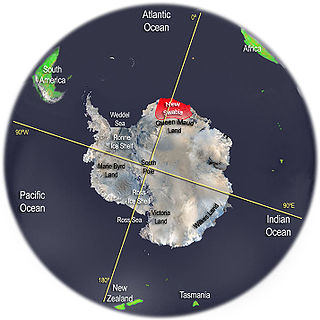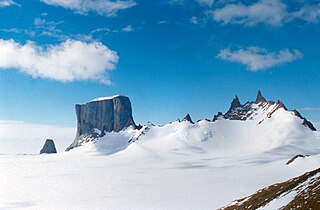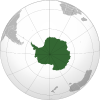
New Swabia was a disputed Antarctic claim by Nazi Germany within the Norwegian territorial claim of Queen Maud Land and is now a cartographic name sometimes given to an area of Antarctica between 20°E and 10°W in Queen Maud Land. New Swabia was explored by Germany in early 1939 and named after that expedition's ship, Schwabenland, itself named after the German region of Swabia.

The Axel Heiberg Glacier in Antarctica is a valley glacier, 30 nmi (35 mi) long, descending from the high elevations of the Antarctic Plateau into the Ross Ice Shelf between the Herbert Range and Mount Don Pedro Christophersen in the Queen Maud Mountains.
The Sør Rondane Mountains are a group of mountains about 100 miles (160 km) long with main peaks rising to 3400 m, between the Queen Fabiola Mountains and Wohlthat Mountains in Queen Maud Land. They were discovered and photographed from the air by members of the Lars Christensen Expedition (LCE) on February 6, 1937, and named after Rondane, a mountain massif in southern Norway. The mountains and their constituent features were mapped in greater detail and named in 1957 by Norwegian cartographers working with air photos taken by U.S. Navy Operation Highjump, 1946–47.

Jøkulkyrkja Mountain, also known as Massiv Yakova Gakkelya, is a broad, ice-topped mountain with several radial rock spurs, standing east of Lunde Glacier in the Mühlig-Hofmann Mountains of Queen Maud Land, East Antarctica. At 3,148 metres (10,328 ft) elevation, it is the highest elevation in Queen Maud Land, and also the highest elevation within the claims of Norway. The mountain is located on the Princess Astrid Coast of the Norwegian Antarctic Territory. Håhellerskarvet, 2,910 metres (9,550 ft), is located to the southwest; the two peaks are separated by the 25-mile-long Lunde Glacier, which flows to the northwest.

Queen Maud Land is a roughly 2.7-million-square-kilometre (1.0-million-square-mile) region of Antarctica claimed by Norway as a dependent territory. It borders the claimed British Antarctic Territory 20° west and the Australian Antarctic Territory 45° east. In addition, a small unclaimed area from 1939 was annexed on 12 June 2015. Positioned in East Antarctica, it makes out about one-fifth of the continent, and is named after the Norwegian queen Maud of Wales (1869–1938).

The Mühlig-Hofmann Mountains is a major group of associated mountain features extending east to west for 100 km (62 mi) between the Gjelsvik Mountains and the Orvin Mountains in Queen Maud Land, East Antarctica. With its summit at 3,148 metres (10,328 ft), the massive Jøkulkyrkja Mountain forms the highest point in the Mühlig-Hofmann Mountains.

The Sverdrup Mountains are a group of mountains about 80 km (50 mi) long, standing just west of the Gjelsvik Mountains in Queen Maud Land, East Antarctica. With its summit at 2,855 metres (9,367 ft), Hamartind Peak forms the highest point in the Sverdrup Mountains.
Raudberg in the Norwegian language means Red Mountain. Three terrain features in East Antarctica bear the name Raudberg:
- Raudberg Pass
- Raudberg Valley
- Raudberget
Storkvarvet Mountain is a mountain in Antarctica that is round in plan and has several radial spurs, standing N of Habermehl Peak at the NE end of the Muhlig-Hofmann Mountains, Queen Maud Land.
Mount Neustruyev is a peak in East Antarctica, 2,900 m, standing 5 mi NNE of Gneiskopf Peak in Südliche Petermann Range, Wohlthat Mountains, Queen Maud Land.

Kreitzerisen is a glacier, 8 nautical miles (15 km) long, flowing north between the Tertene Nunataks and Bamse Mountain in the Sør Rondane Mountains of Antarctica. It was mapped by Norwegian cartographers in 1957 from air photos taken by U.S. Navy Operation Highjump, 1946–47, and named for Lieutenant William R. Kreitzer, U.S. Navy, plane commander on one of the three Operation Highjump aerial crews which photographed this and other coastal areas between 14°E and 164°E.

Koms Glacier is a glacier, 5 nautical miles (9 km) long, flowing north between Mefjell Mountain and Komsa Mountain in the Sør Rondane Mountains of Antarctica. It was mapped by Norwegian cartographers in 1957 from air photos taken by U.S. Navy Operation Highjump, 1946–47, and named Komsbreen.

Gunnestad Glacier is a glacier 13 nautical miles (24 km) long, flowing north between Mount Widerøe and Mount Walnum in the Sør Rondane Mountains of Antarctica. It was mapped by Norwegian cartographers in 1957 from air photos taken by U.S. Navy Operation Highjump, 1946–47, and named for Lieutenant Alf Gunnestad, a pilot with the Norwegian expedition under Lars Christensen, 1933–34.

Gjel Glacier is a glacier, 17 nautical miles (31 km) long, flowing north between the steep cliffs of the Luncke Range and Mefjell Mountain, in the Sør Rondane Mountains of Antarctica. It was mapped by Norwegian cartographers in 1957 from air photos taken by U.S. Navy Operation Highjump, 1946–47, and named Gjelbreen.

Hargreavesbreen is a short, steep glacier flowing northwest between Mount Nils Larsen and Mount Widerøe in the Sør Rondane Mountains of Antarctica. It was mapped by Norwegian cartographers in 1957 from air photos taken by U.S. Navy Operation Highjump, 1946–47, and named for R.B. Hargreaves, an aerial photographer on Operation Highjump photographic flights in this area and other coastal areas between 14°E and 164°E.

Mjell Glacier is a glacier 9 nautical miles (17 km) long, flowing northeast between Mount Bergersen and Isachsen Mountain in the Sør Rondane Mountains of Antarctica. It was mapped by Norwegian cartographers in 1957 from air photos taken by U.S. Navy Operation Highjump in 1946–47, and named "Mjellbreen".

Mefjell Glacier is a glacier, 5 nautical miles (9 km) long, flowing northwest into Gjel Glacier between Menipa Peak and Mefjell Mountain in the Sør Rondane Mountains of Antarctica. It was mapped by Norwegian cartographers in 1957 from air photos taken by U.S. Navy Operation Highjump, 1946–47, and named Mefjellbreen.

Hette Glacier is a glacier, 6 nautical miles (11 km) long, flowing north between the Hettene Nunataks and Austhamaren Peak in the Sør Rondane Mountains of Antarctica. It was mapped by Norwegian cartographers in 1957 from air photos taken by U.S. Navy Operation Highjump, 1946–47, and named Hettebreen.







